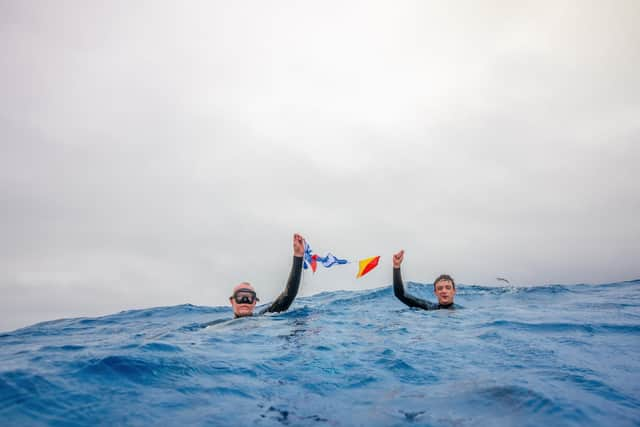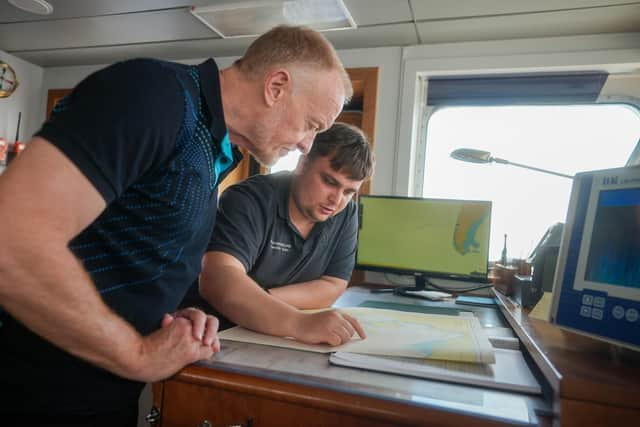Point Nemo: Meet the Yorkshire father and son duo who travelled to the most remote place on Earth
An explorer from Harrogate has successfully completed his expedition to Point Nemo – the most remote place on Earth.
To celebrate the incredible achievement, the 62-year-old tech entrepreneur Chris Brown and his son Mika, 30, donned wetsuits and plunged into the Pacific where they hoisted bunting that spelled N.E.M.O in maritime flags.
Advertisement
Hide AdAdvertisement
Hide AdFinding Nemo means the father-of-two has just two of earth’s “Poles of Inaccessibility” left to visit, the Northern and the Eurasian. Poles of Inaccessibilty are locations which are the most challenging to reach.


After slipping into the water, Mr Brown spent 20 minutes enjoying the world’s loneliest swim – 2,688 kilometres (1,670 miles) from the nearest land.
“It is fantastic to have reached Point Nemo finally after all these years of planning,” he said. “I have been thinking for a while of how to mark the occasion. At all the other Poles of Inaccessibility I have stood with my Garmin, showing the co-ordinates, and the flag of the country.
“But this time I decided to jump into the water and the bunting of the flags spelled out N.E.M.O because it is in international waters. The water was quite bracing, at nine or 10 degrees celsius, but it was the most magnificent blue that you could ever imagine.”
Advertisement
Hide AdAdvertisement
Hide AdOccasional research boats and participants in world yacht races have come close to Point Nemo, without reaching the exact co-ordinates.


And maritime professionals have previously stated that “it is possible that no human has ever passed through the specific coordinates.”
“Whilst it is possible somebody may have inadvertently been to the Nemo coordinates, what we have done is remove any doubt,” said Mr Brown, better known as @chrisbrownexplores on TikTok.
“We couldn’t spend too long in the water as the waves were already up to around two and a half metres. The captain had shown us an impending hurricane force storm, so we had to limit the time we spent at Point Nemo.
Advertisement
Hide AdAdvertisement
Hide Ad“It’s also a fantastic culmination to this specific expedition which has taken us 10 days of sailing through some pretty rough waters to reach this location.
“We took some water samples of the sea, which will be analysed for microplastics on our return, but we were quite pleased to see at least 20 marine birds in our immediate vicinity, which shows there must be some biodiversity at Point Nemo, which has been questioned in the past.
“I am really chuffed to have visited six of the eight Poles of Inaccessibility. I think my next trip will be a little less arduous, maybe somewhere that the most difficult task facing me will be choosing which beer to have at the pool bar.”
Mr Brown and his son, who works as a general manager of a tech company, left for the epic voyage from Puerto Montt in Chile on April 12.
Advertisement
Hide AdAdvertisement
Hide AdPoint Nemo is so remote that the nearest humans to the spot are astronauts in the International Space Station, which is ‘just’ 408km (253 miles) above it in low earth orbit.
Prior to this adventure, Mr Brown had already visited five of Earth’s eight continental Poles of Inaccessibility in Antarctica, Australasia, Africa, North America and South America. He is now the first person to document an expedition to Point Nemo, which is also known as the Oceanic Pole of Inaccessibility. And certainly the first to enter the water.
But Mr Brown says he wasn’t daunted by the dangers of visiting a place where few, if any, humans have ever been before. He said: “I didn’t consider this to be as dangerous as my expeditions to Africa or Antarctica. The obvious danger was that you’re miles from anywhere on the sea, and you’re going to be a long way from any of the shipping lanes so if there was a problem with the boat, help would be a long time coming.
“I’ve been planning this trip for around five years, and finally got firm action plans in place over the last six months. I looked at different methods of getting to Point Nemo. Racing yachts can obviously get there quicker as they’ll be lighter.
Advertisement
Hide AdAdvertisement
Hide Ad“But we knew we would experience tough conditions at 48 degrees South, so I chose something a bit more robust. I thought that tankers could get us there but it’s not a recognised shipping route, so there’s nothing that goes that way. I then came across the Hanse Explorer, which normally takes people down to Antarctica.
“Coincidentally, it was repositioning after the Antarctic summer, which is our winter, from Chile, French Polynesia. And that meant it was going fairly close to where we wanted to be.”
The Hanse Explorer has Zodiac inflatable ribs, which enabled Chris and Mika to get to the exact point because these are more nimble than the Hanse.
The explorer, who logs his adventures on inaccessibility.net, added “After a bit of negotiation, the owners agreed to our slight detour, so it was all systems go.”
Chris first hit the headlines around the world in June last year, when it emerged he pulled out of a trip to the wreck of the Titanic on the doomed Titan submersible amid safety concerns.
Comment Guidelines
National World encourages reader discussion on our stories. User feedback, insights and back-and-forth exchanges add a rich layer of context to reporting. Please review our Community Guidelines before commenting.
